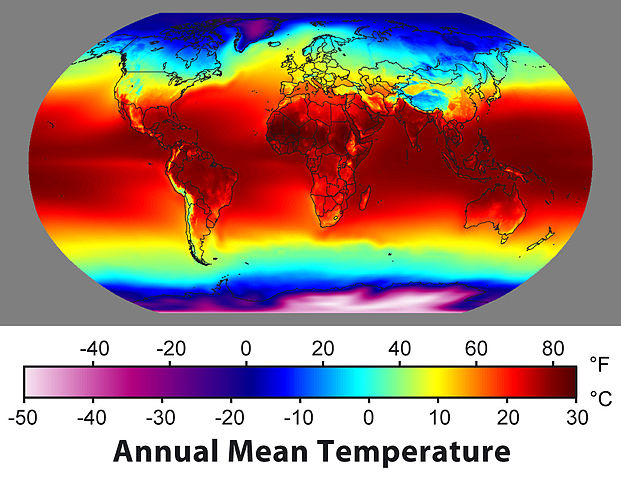
File:Annual Average Temperature Map.jpg

| |
This is a file from the Wikimedia Commons. Information from its description page there is shown below.
Commons is a freely licensed media file repository. You can help. |
Contents |
Summary
This is a global map of the annually-averaged near-surface air temperature from 1961-1990. Such maps, also known as "climatologies", provide information on climate variation as a function of location.
The tropics, between the Tropic of Cancer and Tropic of Capricorn, have the most direct sunlight and highest temperatures. Due to the tilt of the Earth axis, there is relatively little variation in the annual average sunlight received throughout this entire tropics, and hence the entire band has similar temperatures. Above the tropics, temperatures fall off more rapidly as one travels towards the Earth's Poles, at a rate of approximately 1 °C for every 145 km (1 °F per 50 miles). Permafrost will form at positions where the annual average temperature is below 0 °C.
The other key factor in determining surface temperature is elevation. Surface temperature decline ~1 °C for every 220 m (1 °F per 400 ft) in elevation above sea level. The coldest portions of Earth are the Greenland and Antarctic Ice Sheets, which combine both very high latitude and high elevation.
Data sources
This map was produced by combining the 10' CRU CL 2.0 land surface temperature data set (New et al. 2002) with the 1° NOAA OISST version 2 sea surface temperature data set (Reynolds et al. 2002) and the 2.5° NCEP/NCAR Reanalysis version 1 data set (Kalnay et al. 1996). OISST was used for low and mid-latitude ocean temperatures, but NCEP/NCAR was substituted in sea ice forming regions where OISST would over estimate the near surface air temperature. In addition, a small offset was added in all regions to the OISST sea surface temperatures to match the NCEP/NCAR air temperatures, and thus account for the difference between ocean and air. NCEP/NCAR was used for Antarctica, since it was the only data set including this region.
Copyright
This image was created by Robert A. Rohde for Global Warming Art.
 |
Permission is granted to copy, distribute and/or modify this document under the terms of the GNU Free Documentation License, Version 1.2 or any later version published by the Free Software Foundation; with no Invariant Sections, no Front-Cover Texts, and no Back-Cover Texts. A copy of the license is included in the section entitled GNU Free Documentation License. http://www.gnu.org/copyleft/fdl.htmlGFDLGNU Free Documentation Licensetruetrue |
| This file is licensed under the Creative Commons Attribution-Share Alike 3.0 Unported license. | ||
|
||
| This licensing tag was added to this file as part of the GFDL licensing update.http://creativecommons.org/licenses/by-sa/3.0/CC-BY-SA-3.0Creative Commons Attribution-Share Alike 3.0 truetrue |
Une deuxième raison pour laquelle la température de surface dépend de la latitude est la variation de l’épaisseur d'atmosphère traversée par les rayons lumineux. Lorsque les rayons sont perpendiculaires à la surface, l'épaisseur d'atmosphère traversée est la plus faible ; la lumière est moins absorbée et moins diffusée par l’atmosphère et la surface reçoit d'avantage d'énergie solaire. A l’équateur la surface du globe est, côté soleil, perpendiculaire au rayonnement solaire tandis que près des pôles la surface est presque parallèle. L’énergie solaire reçue par unité de surface est donc plus importante près de l’équateur que près des pôles.
References
- New, Mark, David Lister, Mike Hulme, Ian Makin (2000). " A high-resolution data set of surface climate over global land areas". Climate Research 21: 1-25.
- Reynolds, R.W., N.A. Rayner, T.M. Smith, D.C. Stokes, and W. Wang (2002). "An improved in situ and satellite SST analysis for climate". J. Climate 15: 1609-1625.
- E. Kalnay, M. Kanamitsu, R. Kistler, W. Collins, D. Deaven, L. Gandin, M. Iredell, S. Saha, G. White, J. Woollen, Y. Zhu, M. Chelliah, W. Ebisuzaki, W.Higgins, J. Janowiak, K. C. Mo, C. Ropelewski, J. Wang, A. Leetmaa, R. Reynolds, Roy Jenne, Dennis Joseph (1996). " The NCEP/NCAR 40-Year Reanalysis Project". Bulletin of the American Meteorological Society 77 (3): 437–471.
derivative works
Derivative works of this file:
File usage
I want to learn more...
This selection has made Wikipedia available to all children. SOS Children's Villages is an international children's charity, providing a good home and loving family to thousands of children who have lost their parents. We also work with communities to help vulnerable families stay together and raise children in the best possible environment. Have you thought about sponsoring a child?
